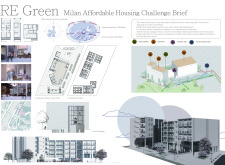5 key facts about this project
The RE Green project embodies a focused approach towards sustainable urban living in Milan, Italy. Designed as a multifaceted solution to housing needs, the project prioritizes affordability while integrating environmentally responsible practices. The layout maximizes functionality and social interaction, promoting a sense of community among residents.
The architectural design incorporates various unit types, including one-room, two-room, and three-room apartments, allowing for diverse occupancy configurations. The strategic arrangement of private and communal spaces ensures that residents have access to both privacy and opportunities for engagement. Central to the development is a flexible community hub that serves multiple purposes, including a marketplace, laundromat, and social area aimed at fostering interactions among residents.
Innovative Community-Centric Design
A distinct aspect of the RE Green project is its community-centric approach, which emphasizes social cohesion. By situating the central communal space within the development, the design encourages inhabitants to engage with one another in shared activities. This flexible space offers venues for local businesses, workshops, and social gatherings, integrating living and community functions that promote a vibrant atmosphere. The design prioritizes pedestrian access, connecting residents to their surroundings and enhancing the overall livability of the environment.
Sustainable Building Practices
This project stands out in its commitment to sustainability and environmental responsibility. The architectural design features green roofs for biodiversity, while solar panels are utilized to generate renewable energy, significantly reducing reliance on traditional energy sources. Material selection focuses on durability and environmental impact, with concrete and glass prominently featured in the construction. By adopting these practices, the RE Green project not only addresses immediate housing needs but fosters long-term ecological sustainability within the urban context.
For detailed insights and to explore architectural plans, sections, and design approaches, a comprehensive review of the project presentation is encouraged. This resource will provide deeper understanding of the architectural ideas that define the RE Green project and its role in shaping contemporary urban living in Milan.






















































